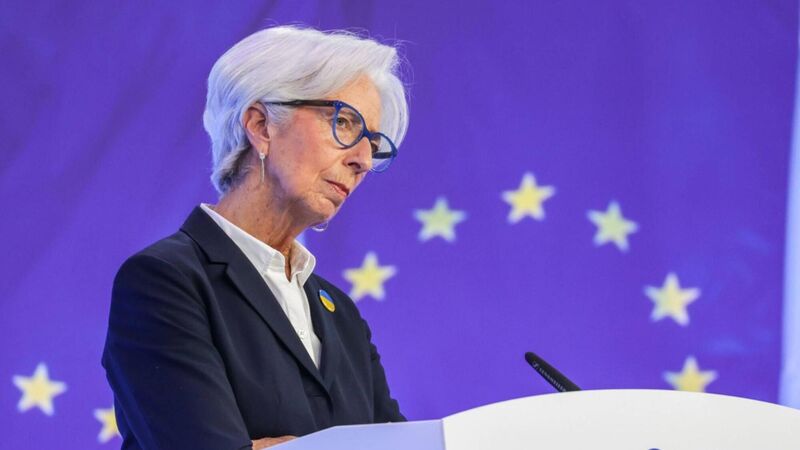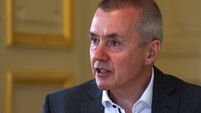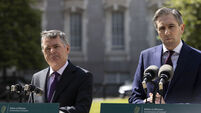2022 will be remembered for inflation, 2023 will be remembered for recession

Christine Lagarde of the European Central Bank. Rates here could rise to 3.5% in 2023.
The year 2022 will be remembered for two things in particular in the world of economics; inflation which jumped to its highest level in 40 years, and the resulting sharp hikes in interest rates by central banks as they strove to bring price pressures back under control.
A year ago, the expectation was that the rise in inflation experienced over the course of 2021 would prove transitory. The inflation rate in the EU climbed from 0.3% in January 2021 to over 5% by the end of the year. The US CPI rate had risen to 7% at the end of 2021. Though these rates are high, the inflation spike was largely put down to supply chain disruptions as economies re-opened post-Covid. These were expected to be resolved over the course of 2022, with inflation falling back.
Central banks were in quite a relaxed mood a year ago despite the sharp jump in inflation. The ECB reassured markets that it did not anticipate having to raise rates in 2022. Meantime, the median projection in December 2021 from US Fed policymakers was that a small 12.5bps hike in rates might be required in 2022 that would take the official rate up to 0.25%.
How things have changed in the space of 12 months. The War in Ukraine was a defining event in 2022. It has brought terrible suffering and destruction to that country and created a major humanitarian crisis in Europe. It also caused major dislocation in global commodity markets, with disruptions to energy and food supplies, in particular, causing wholesale prices to spike higher. This has added greatly to the upward pressures on consumer prices across the globe.
Headline CPI inflation rose to over 11% in both the EU and UK in the autumn, and hit a peak above 9% in the US, levels not seen since the early 1980s. More worryingly, core inflation rates rose significantly as much higher energy costs and rising wages saw greater second-round effects and thus more board-based, marked increases in prices. In the US, the core CPI rate (i.e. excluding food and energy) has been running at 6.0-6.5% for most of this year, while the core rate has also picked up to 6% recently in the EU.
Central banks were slow out of the blocks in responding to higher inflation, but they have been busy this year in making up for lost time. The Fed began raising rates in March and has delivered hikes totalling 425bps since then. The ECB did not start raising rates until July but has increased them by 250bps in total during the second half 2022. Meantime, the Bank of England has raised rates by 340bps over the past year.
The combination of high inflation, big hikes in interest rates and decelerating growth has proved a toxic mix for financial assets in 2022. Quite unusually, both stock and bond markets registered significant losses, with growth stocks, in particular, registering some of the biggest falls. In the US, the S&P 500 is down around 20% this year, while the NASDAQ has fallen by over 30%. Ten-year bond yields have risen by 200-250bps in the US, UK and Eurozone in 2022, due to large declines in bond prices.
Turning to the year ahead, if the story in 2022 was rising inflation and interest rates, it is likely to be around rising recession risks in 2023. Central banks are far from done in terms of tightening policy. Both the Fed and ECB gave clear guidance in their final policy meetings of the year that interest rates have considerably further to rise in the first half of 2023 and by more than markets are expecting.
The Fed has raised rates to 4.375% and there is near unanimity amongst policymakers that they will have to be increased to above 5% in the coming months. The ECB has raised rates to 2% and guided that further 50bps hikes will be required at upcoming meetings to tame inflation, suggesting that rates could rise to 3.5%. The BoE has not taken issue with the market view that UK rates will rise to 4.5% next year from 3.5% currently.
There is a growing risk that the large increases in interest rates and the associated marked tightening of financial conditions, against the backdrop of big declines in real household incomes owing to high inflation, will see many economies go into recession in 2023. The OECD is forecasting paltry growth of less than 1% for advanced economies next year, with the risks tilted to the downside and thus an even weaker outturn.
The Bank of England expects a decline of circa 1% in UK GDP next year and consensus forecasts have started to move into line with this view recently. The ECB is forecasting a short, shallow recession for the Eurozone. Meanwhile, the US economy is expected to largely stagnate in 2023.
The critical element in all of this remains the course of inflation. If it should fall rapidly next year, it will lessen the pressure on real household incomes and allow for an easing in financial conditions, helping growth prospects. The falls in commodity prices in recent months is a positive development, but there is no guarantee that this will prove sustained. Meantime, the concern of central banks is that core inflation will prove sticky. Overall, there is no doubt that a challenging year lies in prospect in 2023.
Oliver Mangan is Chief Economist with AIB










